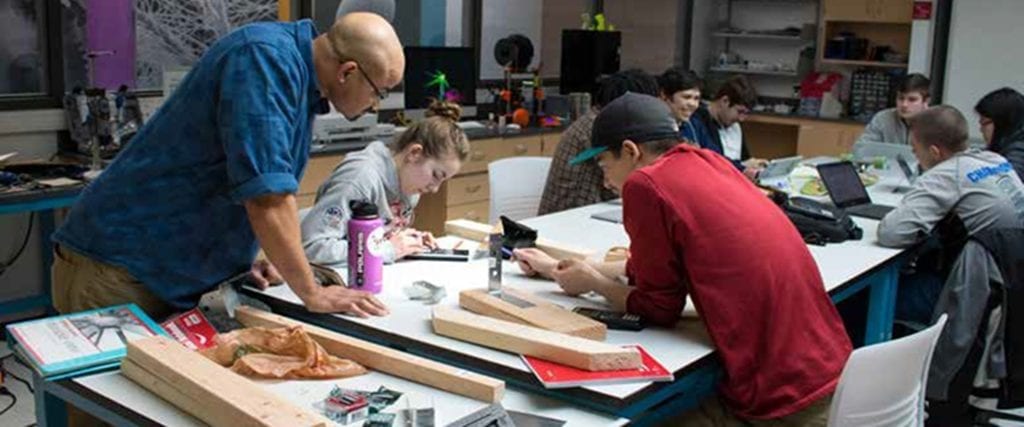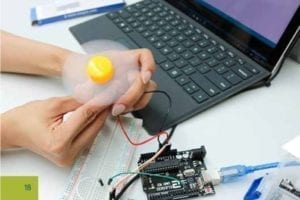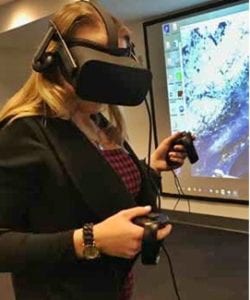
Students can use 3D printers, special tools and VR headsets for free at the MakerSpace and XR Lab
Would you like to experiment with stereolithography, a form of 3D printing that allows for more detail? No? Maybe you’d like to try out the Oculus Rift or HTC Vive, two popular virtual reality headsets? At most schools this high-end technology might be restricted to graduate students, but at Bellevue College it is available to all students at no cost.
The stereolithography equipment is available at the MakerSpace (second floor of Building B), a haven for the experimental/DIY student. This space opened in 2017 and grew organically out of project- based STEM classes, spurred along by then-President Barack Obama’s “Week of Making” in the summer of 2016. Michael Reese, director of BC’s RISE Learning Institute, helped launch and develop the space, but he says it’s the committed group of student employees, led by Honeylieg V. Wiltse, who make the space work.
“The student employees certify users to use equipment,” Reese said. “They make it super vibrant and super helpful. They really create a supportive environment for all levels of students.”

There are four main areas of the MakerSpace: 1) 3D printing, which is very popular and led the group to bump the number of printers from two to four. 2) Electronics, which Reese says has a low barrier to entry because of the many open- source specifications and low-cost basic components. 3) Cutting/carving, which mostly uses wood, plastics and vinyl. 4) Sewing, which includes an industrial sewing machine for costumes, cosplay and wearable electronics.
Reese is also interested in bringing the natural sciences into the MakerSpace, including a plan to 3D print some substrates for microbiology research that might involve the scanning electron microscope in Building S.
A number of clubs meet in the space, including Rocketry & Aero- space Club, Robotics Society and ACM-W, an organization that supports women working in the technology sector. The Service Club also meets there for a project to turn plastic bags into blankets for the homeless.
Student Joseph Pizzolatto is also working on a helpful project. He heard that the Disability Resource Center didn’t want to use LED bulbs because the flickering could cause adverse reactions, and he knew how to solve that issue: a steady current. He’s tinkering in the MakerSpace to create the solution. He says he loves that these types of resources are available to all BC students.
“It provides a free space where we can practice project collaboration,” he said. “There’s lots of free training. You can just show up and be creative.”
XR Lab

The VR headsets can be found in a different type of collaborative environment, the XR Lab on the first floor of the library. The lab assists both students and faculty and currently hosts a communication studies class called Virtual Reality: Design and Communica- tion. Studio Q, inside the XR Lab, is used by professors to create interactive lectures for online courses.
Bruce Wolcott, who leads the lab in conjunction with James Riggall, says they view their role as promoting a valuable emerging technology as well as identifying and installing VR software for a variety of uses.
“We’re primarily here to support students and faculty who want to integrate VR into their learning,” he said. “We’re located within the Bellevue College Library, which is a perfect home for virtual reality resources on campus.”
One common complaint about VR headsets is that they are just another technology that fosters escapism. You put on the headset and the world around you disappears. Technologists, however, take the opposite view.
“The industry sees VR as the future of collaborative workspaces,” Wolcott says. “These are networking tools, not isolative ones.”
Some practical applications can be seen right at Bellevue College. Human anatomy and physiology students can use VR models for practice. Interior design students can quickly build a model, put it into Enscape, and get a photorealistic 3D view of the space.
Wolcott says Seattle’s rich technology sector means a steady stream of top-notch guest presenters have given talks at the lab, including representatives from Google, Amazon and Valve. All agree that students who know how to develop VR hardware or software will be in high demand for the foreseeable future.
– by Russel Whitaker
Last Updated March 5, 2024
